Characteristics and Driving Factors of Nitrogen-Use Efficiency in Chinese Greenhouse Tomato Cultivation
Abstract
:1. Introduction
2. Materials and Methods
2.1. Database Collection, Definitions, and Calculation
2.2. Statistical Analysis
3. Results
3.1. Spatial Distribution
3.2. Management Practices
3.3. Soil Properties
3.4. Driving Factors
4. Discussion
5. Conclusions
Supplementary Materials
Author Contributions
Funding
Institutional Review Board Statement
Informed Consent Statement
Data Availability Statement
Conflicts of Interest
References
- Brunetti, G.; Traversa, A.; De Mastro, F.; Cocozza, C. Short term effects of synergistic inorganic and organic fertilization on soil properties and yield and quality of plum tomato. Sci. Hortic. 2019, 252, 342–347. [Google Scholar] [CrossRef]
- Kuscu, H.; Turhan, A.; Ozmen, N.; Aydinol, P.; Demir, A.O. Optimizing levels of water and nitrogen applied through drip irrigation for yield, quality, and water productivity of processing tomato (Lycopersicon esculentum Mill.). Hortic. Environ. Biotechnol. 2014, 55, 103–114. [Google Scholar] [CrossRef]
- Maham, S.G.; Rahimi, A.; Subramanian, S.; Smith, D.L. The environmental impacts of organic greenhouse tomato production based on the nitrogen-fixing plant (Azolla). J. Clean. Prod. 2020, 245, 118679. [Google Scholar] [CrossRef]
- FAO. Food and Agriculture Data. Available online: https://www.fao.org/faostat/zh/#home (accessed on 27 May 2021).
- Liang, L.; Ridoutt, B.G.; Lal, R.; Wang, D.; Wu, W.; Peng, P.; Hang, S.; Wang, L.; Zhao, G. Nitrogen footprint and nitrogen use efficiency of greenhouse tomato production in North China. J. Clean. Prod. 2019, 208, 285–296. [Google Scholar] [CrossRef]
- Ti, C.; Luo, Y.; Yan, X. Characteristics of nitrogen balance in open-air and greenhouse vegetable cropping systems of China. Environ. Sci. Pollut. Res. Int. 2015, 22, 508–518. [Google Scholar] [CrossRef]
- Qin, X.; Li, Y.; Wang, B.; Wan, Y.; Gao, Q.; Chen, X.; Chen, H.; Song, C. Nonlinear dependency of N2O emissions on nitrogen input in dry farming systems may facilitate green development in China. Agric. Ecosyst. Environ. 2021, 317, 107456. [Google Scholar] [CrossRef]
- Ministry of Agriculture and Rural Affairs. People’s Republic of China. Action Plan for Zero Growth of Chemical Fertilizer Use by 2020. 2015. Available online: http://Www.Moa.Gov.Cn/Ztzl/Mywrfz/Gzgh/201509/T20150914_4827907.Htm (accessed on 27 May 2021).
- Ministry of Agriculture and Rural Affairs. People’s Republic of China. Technical Guidelines for Green Agricultural Development in China. 2018. Available online: http://Www.Moa.Gov.Cn/Gk/Ghjh_1/201807/T20180706_6153629.Htm (accessed on 27 May 2021).
- Kalbani, F.O.S.A.; Salem, M.A.; Cheruth, A.J.; Kurup, S.S.; Senthilkumar, A. Effect of some organic fertilizers on growth, yield and quality of tomato (Solanum lycopersicum). Int. Lett. Nat. Sci. 2016, 53, 56–67. [Google Scholar] [CrossRef]
- Mulvaney, R. Nitrogen—Inorganic forms. Methods Soil Anal. Part 3 Chem. Methods 1996, 5, 1123–1184. [Google Scholar]
- Pan, G.; Zhou, P.; Li, Z.; Smith, P.; Li, L.; Qiu, D.; Zhang, X.; Xu, X.; Shen, S.; Chen, X. Combined inorganic/organic fertilization enhances N efficiency and increases rice productivity through organic carbon accumulation in a rice paddy from the Tai Lake region, China. Agric. Ecosyst. Environ. 2009, 131, 274–280. [Google Scholar] [CrossRef]
- Heeb, A.; Lundegårdh, B.; Savage, G.; Ericsson, T. Impact of organic and inorganic fertilizers on yield, taste, and nutritional quality of tomatoes. J. Plant Nutr. Soil Sci. 2006, 169, 535–541. [Google Scholar] [CrossRef]
- Musyoka, M.W.; Adamtey, N.; Muriuki, A.W.; Cadisch, G. Effect of organic and conventional farming systems on nitrogen use efficiency of potato, maize and vegetables in the Central highlands of Kenya. Eur. J. Agron. 2017, 86, 24–36. [Google Scholar] [CrossRef]
- Hartmann, T.E.; Yue, S.; Schulz, R.; He, X.; Chen, X.; Zhang, F.; Müller, T. Yield and N use efficiency of a maize-wheat cropping system as affected by different fertilizer management strategies in a farmer’s field of the North China Plain. Field Crop. Res. 2015, 174, 30–39. [Google Scholar] [CrossRef]
- Yan, X.; Gong, W. The role of chemical and organic fertilizers on yield, yield variability and carbon sequestration-results of a 19-year experiment. Plant Soil 2010, 331, 471–480. [Google Scholar] [CrossRef]
- Singh, P.; Singh, D.; Singh, A.K.; Singh, B.K.; Singh, T. Growth and yield of tomato grown under organic and inorganic nutrient management. Int. J. Curr. Microbiol. Appl. Sci. 2020, 9, 365–375. [Google Scholar] [CrossRef]
- Du, Y.; Niu, W.; Gu, X.; Zhang, Q.; Cui, B. Water- and nitrogen-saving potentials in tomato production: A meta-analysis. Agric. Water Manag. 2018, 210, 296–303. [Google Scholar] [CrossRef]
- Cheng, M.; Wang, H.; Fan, J.; Xiang, Y.; Tang, Z.; Pei, S.; Zeng, H.; Zhang, C.; Dai, Y.; Li, Z.; et al. Effects of nitrogen supply on tomato yield, water use efficiency and fruit quality: A global meta-analysis. Sci. Hortic. 2021, 290, 110553. [Google Scholar] [CrossRef]
- Abdalla, M.; Hastings, A.; Cheng, K.; Yue, Q.; Chadwick, D.; Espenberg, M.; Smith, P. A critical review of the impacts of cover crops on nitrogen leaching, net greenhouse gas balance and crop productivity. Glob. Chang. Biol. 2019, 25, 2530–2543. [Google Scholar] [CrossRef] [Green Version]
- Niu, J.; Li, Y.; Chen, Q. Solid Organic Waste Fertilizer Utilization Technology; Chemical Industry Press: Beijing, China, 2010. [Google Scholar]
- FAO. World reference base for soil resources 2006: A framework for international classification, correlation and communication. World Soil Resour. Rep. 2006, 2, 103. [Google Scholar]
- Cai, A.; Chang, N.; Zhang, W.; Liang, G.; Zhang, X.; Hou, E.; Jiang, L.; Chen, X.; Xu, M.; Luo, Y. The spatial patterns of litter turnover time in Chinese terrestrial ecosystems. Eur. J. Soil Sci. 2020, 71, 856–867. [Google Scholar] [CrossRef]
- Elith, J.; Leathwick, J.R.; Hastie, T. A working guide to boosted regression trees. J. Anim. Ecol. 2008, 77, 802–813. [Google Scholar] [CrossRef]
- Guo, J.H.; Liu, X.J.; Zhang, Y.; Shen, J.L.; Han, W.X.; Zhang, W.F.; Christie, P.; Goulding, K.W.; Vitousek, P.M.; Zhang, F.S. Significant acidification in major Chinese croplands. Science 2010, 327, 1008–1010. [Google Scholar] [CrossRef] [PubMed] [Green Version]
- Mahmoud, E.; El-Kader, N.A.; Robin, P.; Akkal-Corfini, N.; El-Rahman, L.A. Effects of different organic and inorganic fertilizers on cucumber yield and some soil properties. World J. Agric. Sci. 2009, 5, 408–414. [Google Scholar]
- Qasim, W.; Xia, L.; Lin, S.; Wan, L.; Zhao, Y.; Butterbach-Bahl, K. Global greenhouse vegetable production systems are hotspots of soil N2O emissions and nitrogen leaching: A meta-analysis. Environ. Pollut. 2021, 272, 116372. [Google Scholar] [CrossRef] [PubMed]
- Ma, Q.; Wen, Y.; Wang, D.; Sun, X.; Hill, P.W.; Macdonald, A.; Chadwick, D.R.; Wu, L.; Jones, D.L. Farmyard manure applications stimulate soil carbon and nitrogen cycling by boosting microbial biomass rather than changing its community composition. Soil Biol. Biochem. 2020, 144, 107760. [Google Scholar] [CrossRef]
- Zhang, X.; Fang, Q.; Zhang, T.; Ma, W.; Velthof, G.L.; Hou, Y.; Oenema, O.; Zhang, F. Benefits and trade-offs of replacing synthetic fertilizers by animal manures in crop production in China: A meta-analysis. Glob. Chang. Biol. 2020, 26, 888–900. [Google Scholar] [CrossRef]
- Gai, X.; Liu, H.; Liu, J.; Zhai, L.; Yang, B.; Wu, S.; Ren, T.; Lei, Q.; Wang, H. Long-term benefits of combining chemical fertilizer and manure applications on crop yields and soil carbon and nitrogen stocks in North China Plain. Agric. Water Manag. 2018, 208, 384–392. [Google Scholar] [CrossRef]
- Zhang, T.; Hou, Y.; Meng, T.; Ma, Y.; Tan, M.; Zhang, F.; Oenema, O. Replacing synthetic fertilizer by manure requires adjusted technology and incentives: A farm survey across China. Resour. Conserv. Recycl. 2021, 168, 105301. [Google Scholar] [CrossRef]
- Xia, L.; Shu, K.L.; Ya, X.; Chen, D. How does recycling of livestock manure in agroecosystems affect crop productivity, reactive nitrogen losses, and soil carbon balance? Environ. Sci. Technol. 2017, 51, 7450–7457. [Google Scholar] [CrossRef]
- Chatterjee, R.; Bandyopadhyay, S.; Jana, J.C. Impact of organic amendments and inorganic fertilizers on production potential, nitrogen use efficiency and nitrogen balance in tomato (Lycopersicon esculentum Mill.). IJSK 2014, 2, 233–240. [Google Scholar] [CrossRef]
- Manna, M.C.; Swarup, A.; Wanjari, R.H.; Mishra, B.; Shahi, D.K. Long-term fertilization, manure and liming effects on soil organic matter and crop yields. Soil Tillage Res. 2007, 94, 397–409. [Google Scholar] [CrossRef]
- Mutuku, E.A.; Vanlauwe, B.; Roobroeck, D.; Boeckx, P.; Cornelis, W.M. Physico-chemical soil attributes under conservation agriculture and integrated soil fertility management. Nutr. Cycl. Agroecosyst. 2021, 120, 145–160. [Google Scholar] [CrossRef]
- Ding, W.; Lei, H.; Xu, C.; Ke, H.; Li, H. Characteristics and spatial distribution of apparent nitrogen balance in the greenhouse vegetable cropping system in China. J. Agric. Resour. Environ. 2020, 37, 353–360. [Google Scholar] [CrossRef]
- Burket, J.; Dick, R. Microbial and soil parameters in relation to N mineralization in soils of diverse genesis under differing management systems. Biol. Fert. Soils 1998, 27, 430–438. [Google Scholar] [CrossRef]
- Zotarelli, L.; Dukes, M.D.; Scholberg, J.; Munoz-Carpena, R.; Icerman, J. Tomato nitrogen accumulation and fertilizer use efficiency on a sandy soil, as affected by nitrogen rate and irrigation scheduling. Agric. Water Manag. 2009, 96, 1247–1258. [Google Scholar] [CrossRef]
- Prasad, R.; Shivay, Y.S.; Kumar, D. Current status, challenges, and opportunities in rice production. In Rice Production Worldwide; Springer: Berlin/Heidelberg, Germany, 2017; pp. 1–32. [Google Scholar]
- Wang, X.; Xing, Y. Evaluation of the effects of irrigation and fertilization on tomato fruit yield and quality: A principal component analysis. Sci. Rep. 2017, 7, 350. [Google Scholar] [CrossRef] [Green Version]
- Gu, J.; Wu, Y.; Tian, Z.; Xu, H. Nitrogen use efficiency, crop water productivity and nitrous oxide emissions from Chinese greenhouse vegetables: A meta-analysis. Sci. Total Environ. 2020, 743, 140696. [Google Scholar] [CrossRef]
- Choudhary, O.P.; Ghuman, B.S.; Dhaliwal, M.S.; Chawla, N. Yield and quality of two tomato (Solanum lycopersicum L.) cultivars as influenced by drip and furrow irrigation using waters having high residual sodium carbonate. Irrig. Sci. 2010, 28, 513–523. [Google Scholar] [CrossRef]
- Sánchez-Martín, L.; Arce, A.; Benito, A.; Garcia-Torres, L.; Vallejo, A. Influence of drip and furrow irrigation systems on nitrogen oxide emissions from a horticultural crop. Soil Biol. Biochem. 2008, 40, 1698–1706. [Google Scholar] [CrossRef]
- Lv, H.; Lin, S.; Wang, Y.; Lian, X.; Zhao, Y.; Li, Y.; Du, J.; Wang, Z.; Wang, J.; Butterbach-Bahl, K. Drip fertigation significantly reduces nitrogen leaching in solar greenhouse vegetable production system. Environ. Pollut. 2019, 245, 694–701. [Google Scholar] [CrossRef]
- Ekenler, M.; Tabatabai, M. Effects of liming and tillage systems on microbial biomass and glycosidases in soils. Biol. Fert. Soils 2003, 39, 51–61. [Google Scholar] [CrossRef]
- Zhalnina, K.; Dias, R.; de Quadros, P.D.; Davis-Richardson, A.; Triplett, E.W. Soil pH determines microbial diversity and composition in the park grass experiment. Microb. Ecol. 2015, 69, 395–406. [Google Scholar] [CrossRef]
- Van Veen, J.; Kuikman, P. Soil structural aspects of decomposition of organic matter by micro-organisms. Biogeochemistry 1990, 11, 213–233. [Google Scholar] [CrossRef]
- Ke, J.; Xing, X.; Li, G.; Ding, Y.; Dou, F.; Wang, S.; Liu, Z.; Tang, S.; Ding, C.; Chen, L. Effects of different controlled-release nitrogen fertilisers on ammonia volatilisation, nitrogen use efficiency and yield of blanket-seedling machine-transplanted rice. Field Crops Res. 2017, 205, 147–156. [Google Scholar] [CrossRef]
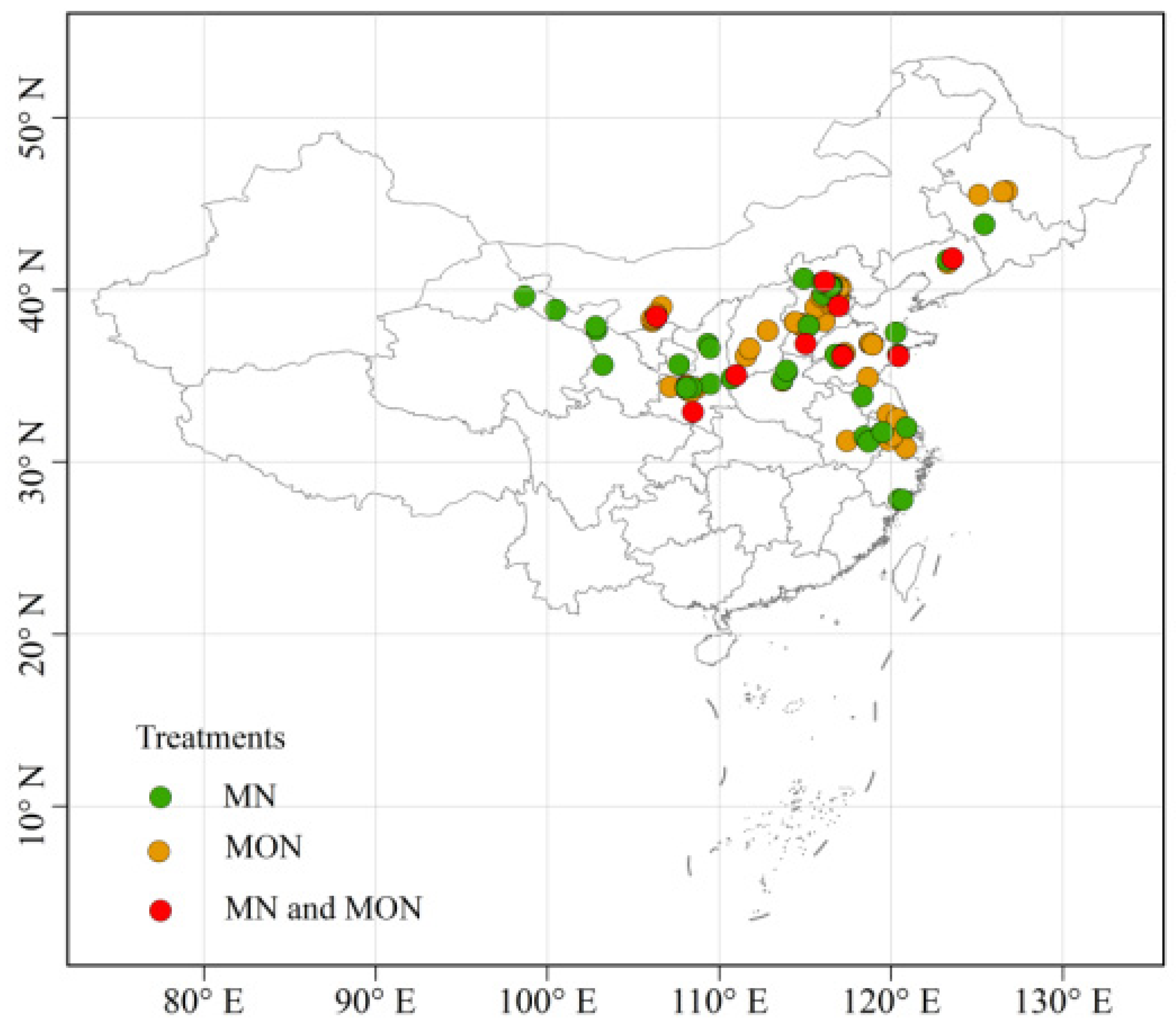
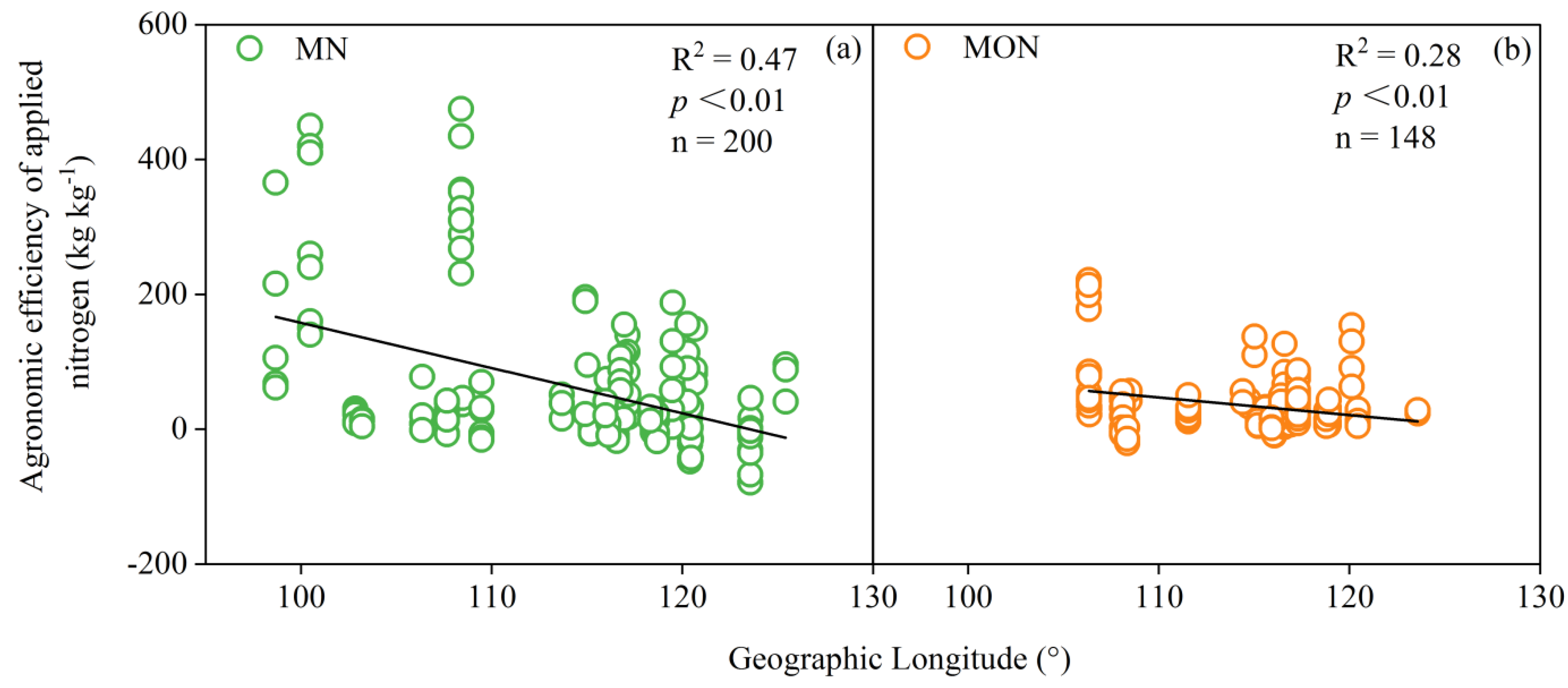
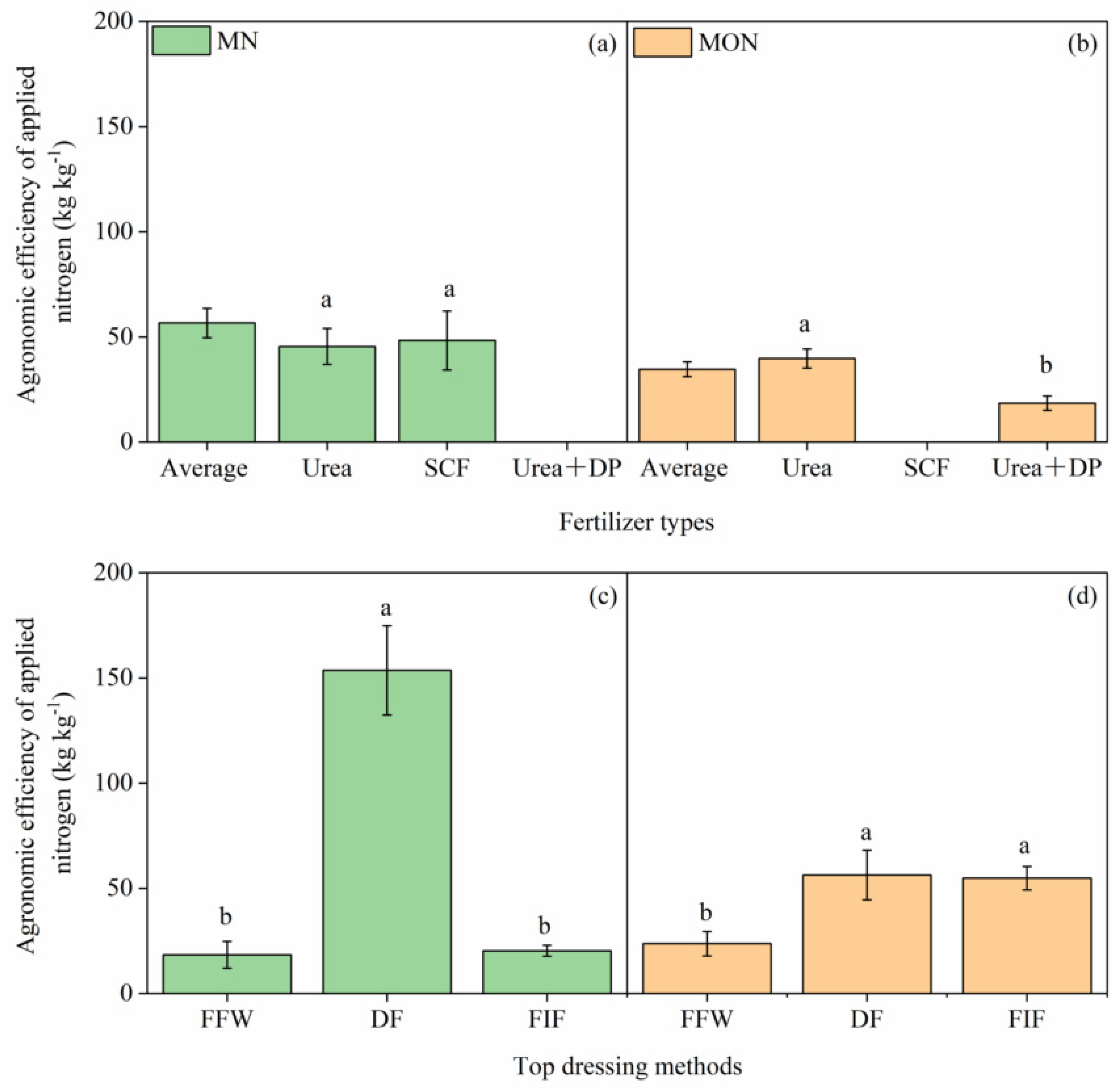
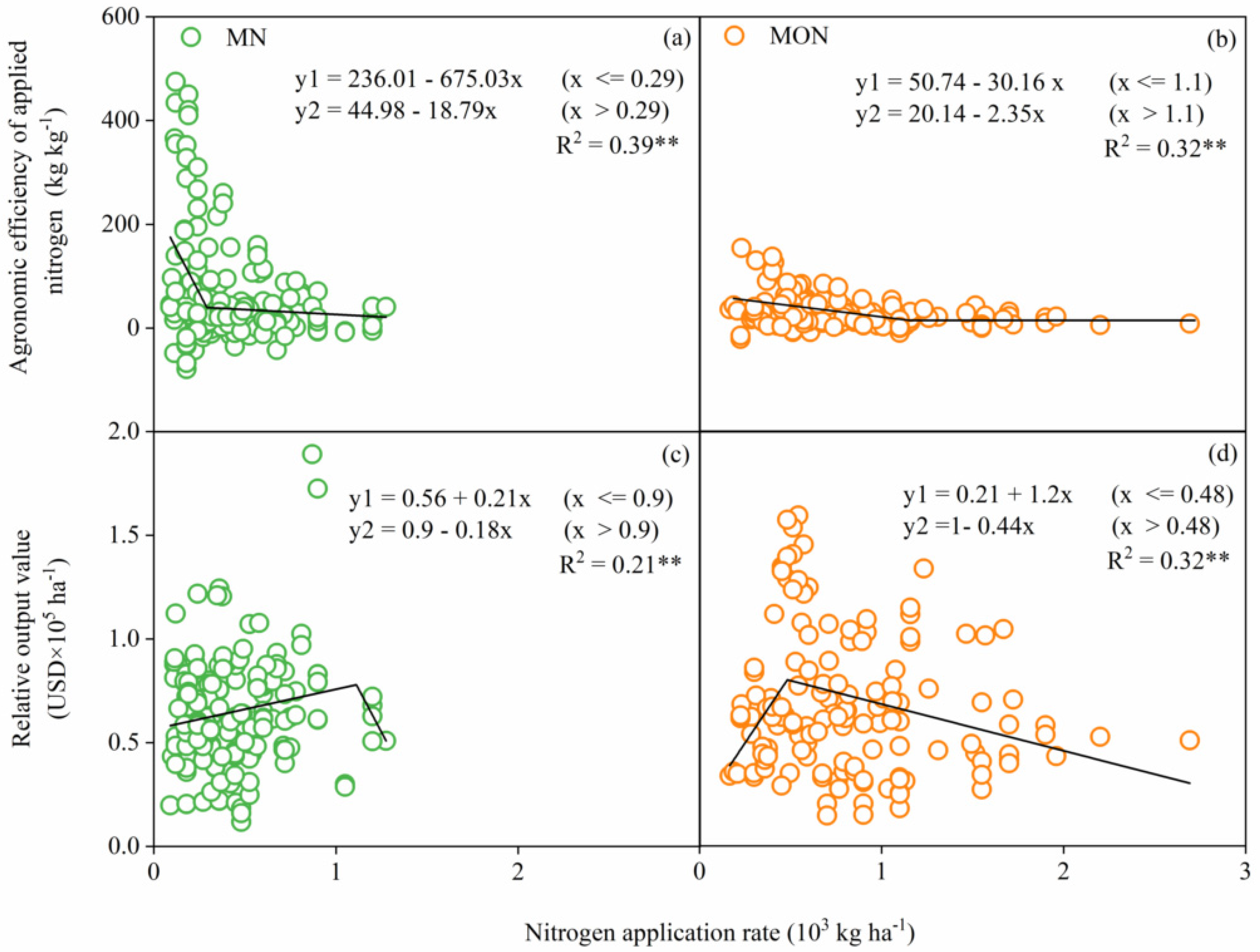
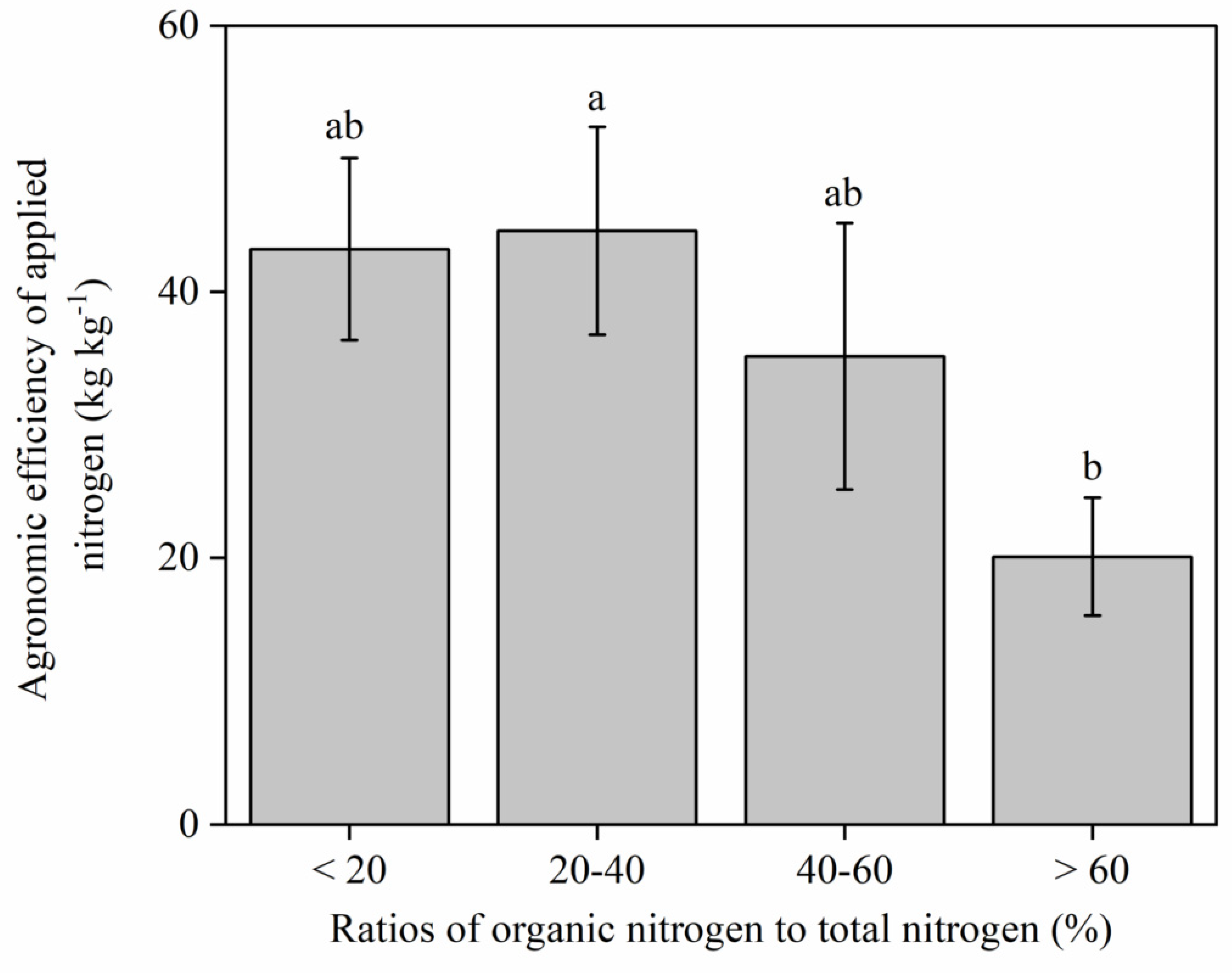
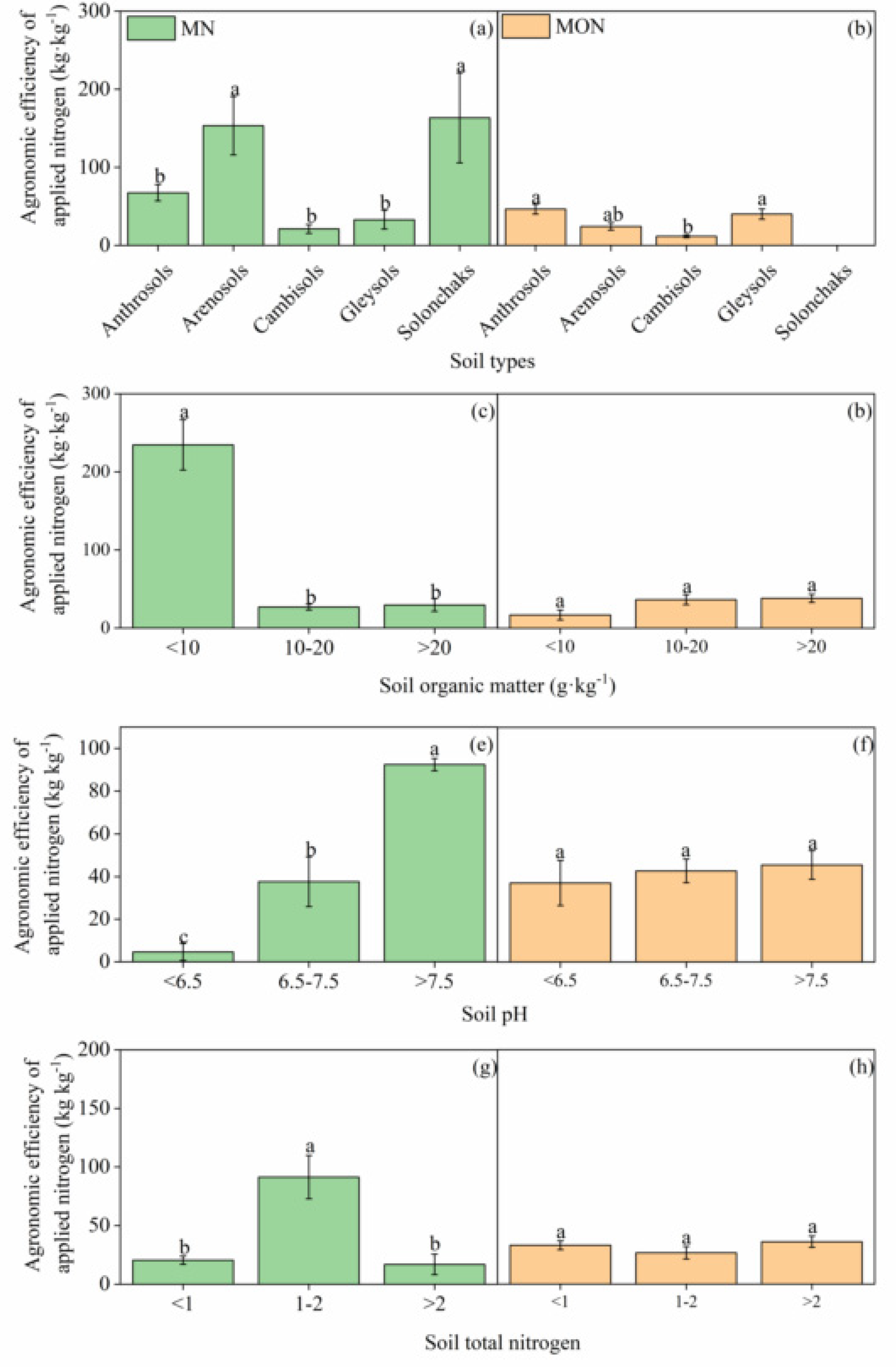

Publisher’s Note: MDPI stays neutral with regard to jurisdictional claims in published maps and institutional affiliations. |
© 2022 by the authors. Licensee MDPI, Basel, Switzerland. This article is an open access article distributed under the terms and conditions of the Creative Commons Attribution (CC BY) license (https://creativecommons.org/licenses/by/4.0/).
Share and Cite
Ren, T.; Li, Y.; Miao, T.; Hassan, W.; Zhang, J.; Wan, Y.; Cai, A. Characteristics and Driving Factors of Nitrogen-Use Efficiency in Chinese Greenhouse Tomato Cultivation. Sustainability 2022, 14, 805. https://doi.org/10.3390/su14020805
Ren T, Li Y, Miao T, Hassan W, Zhang J, Wan Y, Cai A. Characteristics and Driving Factors of Nitrogen-Use Efficiency in Chinese Greenhouse Tomato Cultivation. Sustainability. 2022; 14(2):805. https://doi.org/10.3390/su14020805
Chicago/Turabian StyleRen, Tianjing, Yu’e Li, Tiantian Miao, Waseem Hassan, Jiaqi Zhang, Yunfan Wan, and Andong Cai. 2022. "Characteristics and Driving Factors of Nitrogen-Use Efficiency in Chinese Greenhouse Tomato Cultivation" Sustainability 14, no. 2: 805. https://doi.org/10.3390/su14020805





